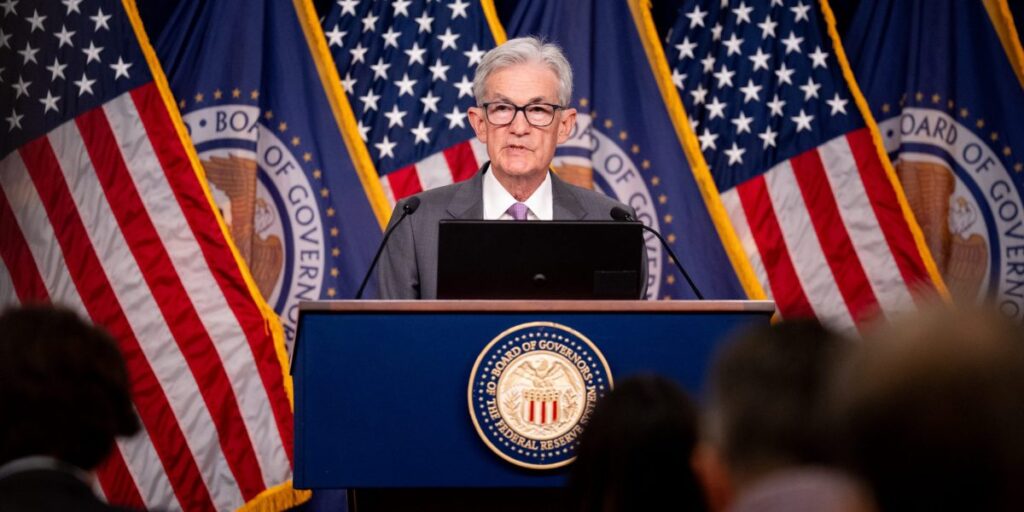Powell faces a mutiny on Wall Street if he doesn’t make a September rate cut
“The bottom line is that the weaker-than-expected July employment report led us to change our baseline expectation for the first Fed to September.”


Following the last Federal Open Market Committee meeting, chairman Jerome Powell left the door open for holding interest rates where they are—at5.25%-5.50%—until December before beginning to bring them down.
But Friday’s job report came in far cooler than expected. The U.S. added only 114,000 jobs in July, the Bureau of Labor Statistics said on Friday, well below expectations of approximately 175,000. The unemployment rate went up to 4.3% on the expectation that it would stay flat at 4.1%.
Now questions are mounting as to whether the Fed has left it too late.
International markets—looking nervously at the world’s biggest economy—have been tumbling ever since: At the time of writing Japan’s Nikkei 225 is down more than 12%, its worst day since the ‘Black Monday’ of 1987. Europe’s regional Stoxx 600 is down 2.55% at the time of writing with U.S. futures also taking a hit.
The unexpected drop in the jobs number caused analysts to quickly revisit their projections for the rest of the year.
Previously Bank of America had been certain the first cut would come in December but on Friday the lackluster jobs report was enough to bring its expectation forward to September.
“The bottom line is that the weaker-than-expected July employment report led us to change our baseline expectation for the first Fed cut from December to September,” wrote BofA’s U.S. economics team in a Friday note seen by Fortune, adding it had “locked in” the cut.
“Overall, the labor market is cooling, but without a sharp slowdown,” said analysts Michael Gapen, Aditya Bhave, Stephen Juneau, Shruti Mishra, and Jeseo Park.
The economists point out that Hurricane Beryl in Texas meant 436,000 nonagricultural workers said they were employed but unable to work because of bad weather.
“The increase in the number of unemployed this month is due to job losers on temporary layoff versus other job losers,” the group wrote. “Hence, we don’t think 114k payrolls is the new trend. The three-month moving average is closer to 175k which is more likely where the trend is.”
While the jobs report, in Bank of America’s opinion, isn’t as big a blow as it may initially appear the institution still expects the Fed to cut by 25bps in September.
The cuts will continue until rates hit the range of 3.25-3.5%, the analysts said: “If the economy is cooling faster than we or the Fed anticipated, then it would point to a lower need for a higher-for-longer policy stance.”
Likewise UBS is calling for an acceleration in cuts.
In a note seen by Fortune published Friday the bank’s senior U.S. economist, Brian Rose, wrote: “With the unemployment rate above and core PCE inflation now below the Fed’s year-end forecasts, we believe that the balance of risks favors more aggressive action by the Fed.
“We are changing our base case to rate cuts of 50 basis points in September and 25 basis points each in November and December, for a total of 100 basis points by year-end.”
With analysts further firming up their stance for a cut, Wells Fargo has warned if Powell doesn’t make his move then Wall Street will react abruptly.
Mike Pugliese, senior economist at Wells Fargo, told Fortune even prior to the jobs report: “Based on what we know now, no rate cut in September would come as a major surprise to us and to financial markets. Financial conditions likely would tighten if the FOMC adopted an unexpectedly hawkish stance over the next seven weeks.”
Sahm signals recession
July’s jobs report also ticked over a metric which economists have been nervously watching for months.
The Sahm Rule in the past has been fairly accurate in signalling when the U.S. is about to head into a recession.
The metric looks at two factors: the current three-month moving average of U.S. unemployment and the lowest three-month moving average of U.S. unemployment over the past year. If the current average is higher than the lowest average by more than half a percentage point, the American economy is headed for a recession.
Up until last month, the index had been below 0.5%. However, in July it ticked up to 0.53%.
That said, the creator of the rule itself, Claudia Sahm, said “no one should be in panic mode.”
“This time really could be different,” she told Fortune last week. “[The Sahm Rule] may not tell us what it’s told us in the past, because of these swings from labor shortages, with people dropping out of the labor force, to now having immigrants coming lately.”
Market upset
But not everyone received the “don’t panic” memo.
While a range of factors has contributed to the global sell-off in equities (oil prices, geopolitical tensions, discrepancies between foreign exchange rates making deals less lucrative), concerns about the U.S. economy entering a recession have not helped.
Ahead of the FOMC meeting at the end of July, former president of the Federal Reserve Bank of New York Bill Dudley said the Fed need to cut rates as soon as possible.
Now names like Tesla CEO Elon Musk and Pershing Square founder Bill Ackman are asking the same question.
“The Fed needs to drop rates,” Musk wrote on social media platform X yesterday. “They have been foolish not to have done so already.”
Likewise Ackman—who has been pushing for cuts since late last year—wrote early on Monday: “The Federal Reserve was too slow to raise rates. Now it is too slow to lower them.”
The Federal Reserve was too slow to raise rates. Now it is too slow to lower them.
— Bill Ackman (@BillAckman) August 5, 2024







